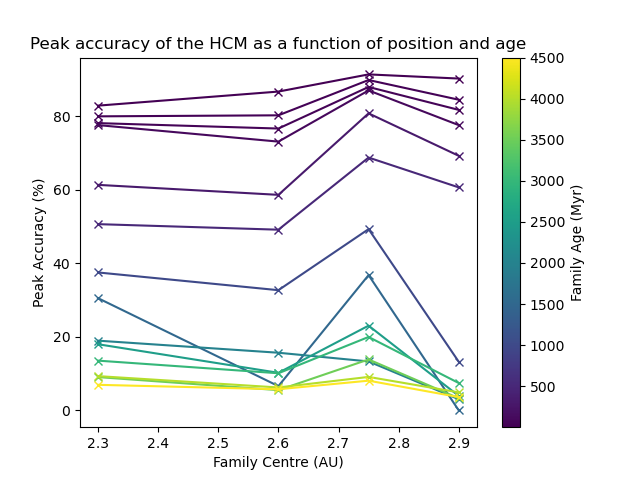- 1Armagh Observatory and Planeterium, College Hill, Armagh, BT61 9DB, United Kingdom of Great Britain – Northern Ireland
- 2Observatoire de la Côte d’Azur, CNRS-Lagrange, Université Côte d’Azur, CS 34229, 06304 Nice Cedex 4, France
- 3Solar System Science & Exploration Division, Southwest Research Institute, 1050 Walnut Street, Suite 300, Boulder, CO 80302, USA
The Hierarchical Clustering Method (HCM) has been the main algorithm for clustering asteroids into groups of similar origins, i.e. into families, since the early 1990s [1][2]. With surveys such as NEOWISE, GAIA and the future LSST providing large amounts of asteroid observations it is necessary to analyse the efficiency of the HCM at handling the exponentially larger volumes of data. Our work aims to investigate how the effectiveness of the HCM can be characterised, with respect to an asteroid family’s age, location, and the density of the background it is situated in.
The efficiency of an algorithm can primarily be noted through two conditions, its ‘accuracy’ and its ‘precision’. These are the metrics we have used to measure the HCM. The accuracy of an algorithm is a measure of the completeness of correct identification of background and family asteroids. Precision measures the ratio to correctly and incorrectly identified asteroids within a sample from the data set. Accuracy is useful for estimating the number of family members that the HCM will have missed, and precision for the number of interlopers that have contaminated the sample the HCM returns. This experiment was undertaken using a synthetic background generated by Rogerio Deienno, akin to his investigation into the Yarkovsky V-Shape Method [3]. Four families were generated at different points in the main-belt, and with ages varying from 10 Myr to 4.5 Gyr.
The HCM was varied with cut-off velocities ranging from 10 to 1000 m/s.The cut-off with the highest overall accuracy was taken, and the precision at this point was measured. Our results show that position within the main belt made little difference to the efficiency of the algorithm. At the theoretical peak accuracy, the youngest families returned accuracy values ranging from 80-91%, with precision varying between 90-95%. No family older than 1.5 Gyr had an accuracy value of greater than 50%, and families older than 2.5 Gyr scored maximum values of 19% or lower. The precision for older families varied greatly as the cut-off velocity was increased. By limiting the survey cut-off velocity, it was possible to keep the precision higher, however this was at the expense of accuracy, trading family completeness for a reduction in interlopers.
The HCM algorithm suffers from a problem of ‘chaining’. When the algorithm branches from a parent body to agglomerate nearby asteroids, clusters of nearby interloper asteroids act as a bridge that can cause the branching to extend outside of the family. This problem worsens as families age and dissipate, or if there are more background asteroids that will interfere and act as interlopers. With the growing datasets this problem will be exacerbated, and the continued use of the HCM as a tool for asteroid family clustering ‘as is’ must be addressed.

Figure 1: The plot depicts the variation of peak accuracy of the HCM with respect to a families position and age within the main belt. Older families are lighter coloured, and younger families darker.
References:
[1] Zappala, V., Cellino, A., Farinella, P., and Knezevic, Z., (1990). Asteroid Families. I. Identification by Hierarchical Clustering and Reliability Assessment, The Astronomical Journal, vol. 100, IOP, p. 2030, 1990. doi:10.1086/115658.
[2] Zappala, V., Cellino, A., Farinella, P., & Milani (1994), Asteroid Families. II. Extension to Unnumbered Multiopposition Asteroids, A. Astronomical Journal (ISSN 0004-6256), vol. 107, no. 2, p. 772-801, 1994AJ....107..772Z
[3] Deienno, R., Walsh, K., Delbo, M., (2021). Efficiency characterization of the V-shape asteroid family detection method. Icarus. 357. 114218. 10.1016/j.icarus.2020.114218.
How to cite: Marshall-Lee, A., Delbo, M., Christou, A., Deienno, R., and Walsh, K.: The Efficiency of the Hierarchical Clustering Method, Europlanet Science Congress 2024, Berlin, Germany, 8–13 Sep 2024, EPSC2024-980, https://doi.org/10.5194/epsc2024-980, 2024.